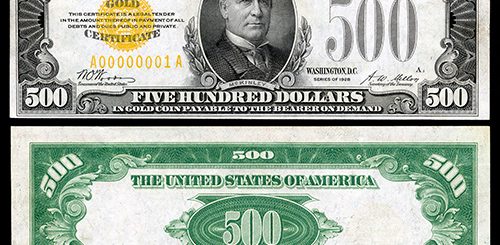Buyer’s Guide For The 1928 FRN St Louis $500 Note

The 1928 $500 Federal Reserve Note is considered high denomination, as its value is dependent on a number of factors, including the color of the seal, district of issue, star note, and of course the condition. Out of the 1.6 million bills that were originally printed, it is estimated that just over 130,000 of them survive to date.
The Federal Reserve Note is also known as the United States banknote, and is the currency that is and has been used in the U.S. since the founding of the Federal Reserve in 1913. It is considered legal tender, and different variations of this currency have been issued over the last one hundred plus years, with some versions becoming exceedingly rare and of great value to collectors.
The Issuing Districts
This particular note was issued by each of the 12 banks that comprise the Federal Reserve. The bank of issue is extremely important when attempting to determine the value of any currency. In this case, the bank of issue can be found by reviewing the black colored seal which is visible from the front on the left side, within the seal. Of all the 1928 FRN notes that were issued, the most sought after are the ones which are designated “A,” which means they were produced in Boston.
The Serial Number And Color
One of the things which influence the value of this particular note is the serial number. Specifically, low digit numbers such as 000000## will place a premium on any of the $500 1928 FRN notes. In regards to color, these bills were printed mostly in light and dark green. These colors are most evident in the seals, with the lighter ones being issued after the darker ones. The color of the seal carries a premium.
The Condition And Star Note
The majority of high denomination bills were not utilized for daily transactions which mean that they tend to remain in better condition than their lower denomination counterparts. At any point when a bill becomes subject to tears, missing parts or rust, it will adversely impact its price. Currency specialists can evaluate a piece of currency and the extent of damage in order to determine its value.
The star note is very important for currency collectors, and if one appears inside the serial number – this is quite significant, particularly for the 1928 $500 FRNs. These notes have a serial number of eight digits, and whenever a star can be seen at the end of the number, this can dramatically increase the value of the note. A bill that doesn’t have a star symbol might be worth $700 while a bill with a star could be worth $17,000. Although each district issued notes with star symbols, only a few are known to have survived until the present day, making them extraordinarily valuable.


